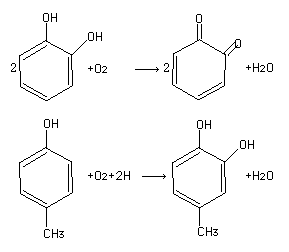Polyphenol OxidaseI.U.B.: 1.14.18.1 C.A.S.: 9002-10-2
Enzymatic Reaction (image will open in a new window) Polyphenol oxidase (tyrosinase) (TY) is a bifunctional, copper-containing oxidase having both catecholase and cresolase activity (Malmström and Rydén 1968): Jolley et al. (1974) refer to it as an oxygen and 4 electron-transferring phenol oxidase. It is responsible for browning reactions throughout the phylogenetic scale. Although a tyrosinase from Neurospora crassa has been purified (Fling et al. 1963), most work has been done with the mushroom enzyme, even though yields and consistency are poor; its multiplicity was shown by Smith and Krueger (1962). Bouchilloux et al. (1963) obtained four enzymes. See review by Nelson and Mason (1970). Characteristics of Polyphenol Oxidase from Mushroom:Molecular weight: 128,000 (Duckworth and Coleman 1970). Composition: The enzyme is a tetramer containing four gram atoms of copper per molecule (Jolley et al. 1974), and two binding sites for aromatic compounds including phenolic substrates. There is also a distinctly different binding site for oxygen, the copper site (Duckworth and Coleman 1970). The copper is probably in the cuprous state; inactivation of the enzyme is associated with increase in Cu2+. (Kertész et al. 1972). The amino acid composition has been determined. Extensive structural studies have been reported by Jolley et al. (1969); and Duckworth and Coleman (1970). See also Jolley et al. (1972, 1973, and 1974). Optimum pH: 6.0-7.0. Extinction coefficent:
Inhibitors: Compounds that complex with copper. The enzyme is also inhibited competitively by benzoic acid with respect to catechol and by cyanide with respect to oxygen (Duckworth and Coleman 1970). Activity: Polyphenol oxidase is an oxygen transferring enzyme. Besides using O2 to catalyze the dehydrogenation of catechols to orthoquinones and the orthohydroxylation of phenols to catechols, a peroxidase activity has been reported on by Strothkamp and Mason (1974). Kinetic studies have been reported by Kertész et al. (1971). See also the review by Malmström and Rydén. Specificity: A large number of parasubstituted catechols areoxidized (Duckworth and Coleman 1970). Stability: The lyophilized preparation is stable for 6-12 months when stored at -20°C. |

 Place Order
Place Order